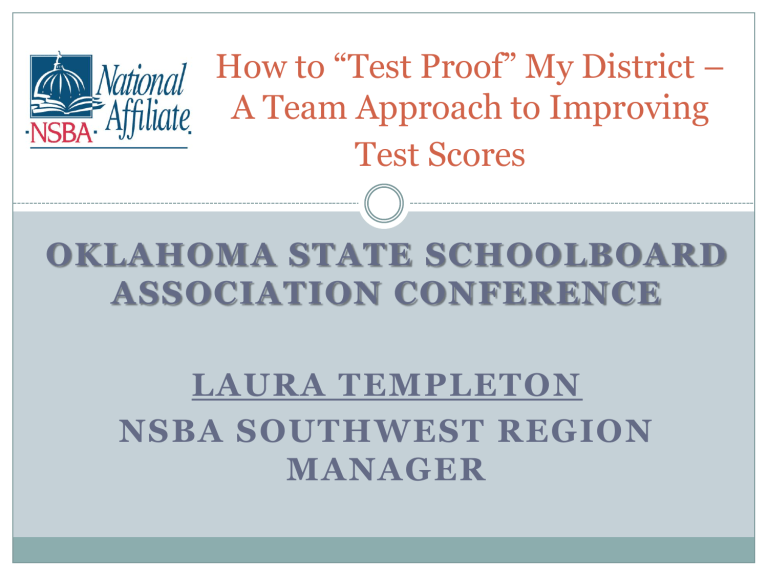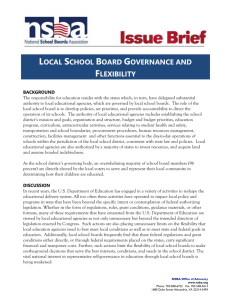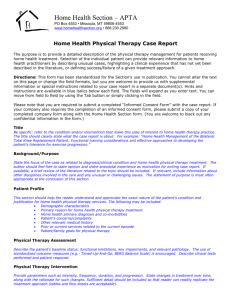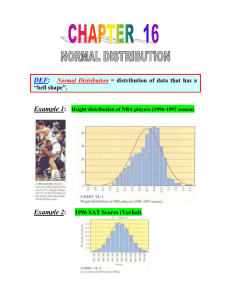How to *Test Proof* My District - Oklahoma State School Boards

How to “Test Proof” My District –
A Team Approach to Improving
Test Scores
OKLAHOMA STATE SCHOOLBOARD
ASSOCIATION CONFERENCE
LAURA TEMPLETON
NSBA SOUTHWEST REGION
MANAGER
A Short Test
We have 10 minutes to take a short pre-test that will help to focus on today’s presentation.
Please relax and give it your best shot!
If you’re not sure about an answer– at least give your opinion!
Any Questions?
A Short Test
BEGIN…..
END
Please pass up your tests
A Short Test
Goals (Vision)
What are your goals for today’s session?
Goals (Vision)
My Goal………
To help you and your board to become
Stewards of Success!
Agenda
A Short Test!
Educational Leadership
What is the Best Indicator of a District’s Success?
Why Do We Test?
What is “Standardized”– Is my District?
Test Taking Skills
Data First
Center For Public Education
How Can I Make This Happen
Contact Information
Who is Laura Templeton
University of Texas, Austin
Indiana-Purdue University
Indiana University, Bloomington
Supervised and Coordinated the Overseas Student Teaching
Project
Taught elementary, secondary, and University levels
Worked in Educational Publishing for over 20 years
Development Manager, Southwest Region NSBA
PART I
ED U C A TI ON A L LEA D ER S HI P -
S TE W A R D S O F S U C C E S S
WHO A R E THE E D U C A TI ON A L
LE A D E R S I N MY D I S TR I C T
?
Educational Leadership
Who are the educational leaders in my district?
Educational Leadership STARTS AND ENDS WITH THE
BOARD.
This is the core of a district’s teamwork system.
“Local Boards are no longer merely overseers of school systems : they are leaders of public education in their states and communities”
• “Key Work of School Boards-
Handbook”
Educational Leadership
It is the charge of every board to create
optimal conditions for teaching and learning.
It requires that boards
-- understand issues deeply
--align resources
--foster a positive atmosphere for all parties
(Administrators, Teachers and Learners)
This is at the heart of “data driven decision making”
RTTT and New Proposed ESEA both lean heavily on
“DDDM”
Educational Leadership
Where is the first place that a board must look to begin the move toward
Educational Leadership and
Academic Excellence? In other words where do we begin our journey in becoming “Stewards of
Success”?
Educational Leadership
OSSBA
Professional Development
Annual Conference
Publications
Website
District and Local Meetings
Link to NSBA
Educational Leadership
“Key Work of School Boards” Lead for Systemic Change!
-Vision
-Standards
-Assessment
-Accountability
-Alignment
-Climate and Culture
-Collaborative Relationships/Community Engagement
-Continuous Improvement
These focus points should be incorporated in all district functions– they are the cornerstone of every successful district
PART II
What is the Best
Indicator of a
District’s Success?
What is the Best Indicator of a
District’s Success?
Discussion
--SAT/ACT results?
--Graduation rate?
--Daily Attendance?
--Standing on the state test?
--Standing in regard to AYP?
--Staff credentials?
--Football Record?
What is the Best Indicator of a
District’s Success?
It is up to you to decide– you are the educational leaders in your community.
It should be a mixture of the discussion points.
The foundation of American Education is the
SCHOOL BOARD– remember you all know your community’s needs better than anybody else.
Remember that if your district vision is educationally sound- it should be your yardstick.
But don’t forget we still have to deal with federal and state mandates.
PART III
What does my district do to prepare students for our state tests/
SAT’s/ACT’s?
Student Preparation
Are we as educators doing everything that we can to help kids do well on required tests, such as, state tests or required entrance tests?
Student Preparation
Yearly sales in millions
-- Sylvan Learning- 900 learning centers/ 2 million students
Part IV
Why Do We
Test?
Why Do We Test?
We test to measure progress toward a standard or goal.
Why Do We Test?
We should also test to……
-- Diagnose
-- Determine Strengths and Weaknesses in both students and teachers
--Measure and Judge our curriculum
--Aid in teaching
--Measure and judge/adjust our teaching
Why Do We Test?
If we only test to measure periodic progress toward a goal, we are doing a great disservice to our students.
Testing should be an integral part of teaching.
Part V
What is a
Standardized Test?
Is My District?
What is Standardized? Is My
District?
A standardized test is any test given with the same items and directions-
-- IN OTHER WORDS, JUST
ABOUT EVERY TEST GIVEN TO
THE STUDENTS IN YOUR
DISTRICT IS A STANDRDIZED
TEST!
What is Standardized? Is My
District?
Your district should have a standardized approach to testing.
Quick discussion—
Does your district have intermittent assessments?
What grade levels and how often?
What is Standardized? Is My
District?
Does my district have a
TESTING Policy?
If so tell us about it………
If not, let’s look into what it should entail…….
What is Standardized? Is My
District?
What are some key points and questions for a district testing policy..
Frequency of tests-- there should never be large gaps in assessing a student’s progress.
Number of items per objective must be appropriate.
Retests required for failures.
Tests must be signed by a parent or guardian regardless of score.
Are textbook tests (unit and chapter) appropriate.
A team approach to test creation may be mandated.
What is Standardized? Is My
District?
A district must make testing an integral part of its curriculum and must monitor the use of tests on an ongoing basis.
Testing should then never be looked at as something other than a learning process.
If a district has properly aligned its curriculum and works to make testing a part of the learning process, achievement and required state and federal test scores will go up.
Part VI
Test Taking
Skills
Test Taking Skills
How often do we hear the statement----
“My son or daughter is a really good student but doesn’t show it because he/she isn’t very good at taking tests”
Could this be true? Yes there are some kids with learning disabilities and who have IEP’s that dictate how they must take tests. But we’re not talking about those kids– the one in the statement has no IEP or LD, he or she chokes on tests. Is this believable?
Test Taking Skills
Yes this can be true! There are many, many kids who do choke on test.
It is possible to create test anxiety.
We have to take a different approach– we have to teach students to take tests.
This is not easy but it is the type of systemic
change that is necessary for “test proofing”.
Test Taking Skills
Test developers and test prep companies have found that the following test taking skills are key to a students doing well on most forms of multiple choice tests (and most tests in general)
1. Answer Transfer
2. Test Manipulation
3. Rote Practice
Test Taking Skills
ANSWER TRANSFER
The Question is in a test booklet and I have to put the answer on another sheet and possibly do the required work on a scratch piece of paper!
Some Remedies
1. Drill practice using separate sheets
Test Taking Skills
TEST MANIPULATION
The student becomes overwhelmed with the actual taking of a large scale test.
Some Remedies
1. Practice with multiple directions
2. In the reading comprehension section skim the questions before reading the passage
3. use simple estimation on math problems/ practice speed drills
4. Learn to drop the obviously incorrect answer choice.
5. Have the students make test questions on material and have them
“test the teacher” or each other (under close observation)
6. Rote Practice and Transfer
Test Taking Skills
General Remedies
1. Have teachers take practice test with students as a learning activity –Out-loud strategizing.
2. Always go over a test no matter how well or poorly the kids do!
3. Make sure that there is plenty of practice using the test format from state mandated tests.
4. Promote pre-testing with the introduction of new concepts.
5. Promote test sharing throughout grade and subject levels.
6. Have department and grade level teachers take and critique each others tests.
7. Create and adhere to a district testing policy and plan.
8. Make sure that there is plenty of good professional
development to make your district testing plan/policy a reality.
Scenario: Engage the community
Your district has a persistently low-achieving school.
Your superintendent has data showing this school also has high teacher turnover and a high proportion of new teachers. She wants the board to approve an incentive plan to lure the district’s best teachers to this school. Parents in high-achieving schools protest.
What would a data-driven board do?
Examine your teacher distribution data
Look at best practices in teacher recruitment & retention
Involve your teachers
Engage your community
Where do we start?
Data Center
National & state data for 28 indicators
Percent of highly qualified teachers under NCLB
Percent of teachers knowledgeable in their field
What the data says. What the data doesn’t say.
Indicators are proxies for teacher effect
Learn more
Key questions about distribution
Other characteristics of teacher quality
Look at best practices in teacher recruitment and retention.
Learn more about good teachers
Promise or Peril? What works in teacher pay for performance plans
How good are your teachers?
Wanted: Good Teachers
A guide to growth models
Involve your teachers
Engage your community
The data made me do it!
How the Center can help school boards in their work
www.centerforpubliceducation.org
Support for school boards
Eight characteristics of effective school boards
1.
2.
3.
4.
5.
6.
7.
8.
Commit to a vision of high expectations for student achievement and define clear goals to fulfill that vision
Have strong shared beliefs about the ability of students to learn and in the system’s ability to teach them
Are accountability-driven; spend more time focused on student achievement and less on operational issues
Have a collaborative relationship with staff
Are data savvy; use data to monitor and drive continuous improvement
Align and sustain resources to achieve goals
Lead as a united team with the superintendent
Take part in team development and training
questions?
Contact Information
Laura Templeton
NSBA Regional Manager, Southwest Region
713-668-5342 ltempleton@nsba.org









